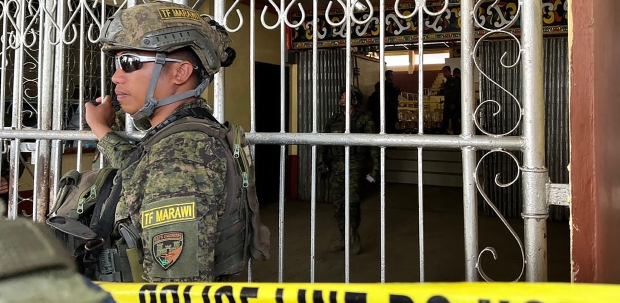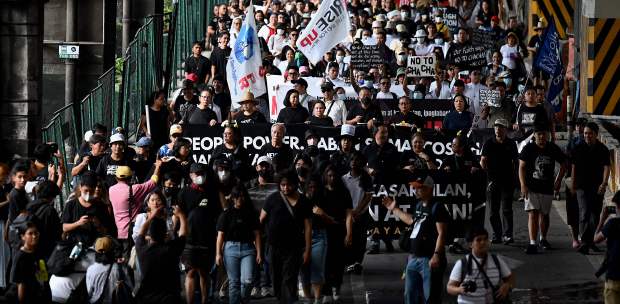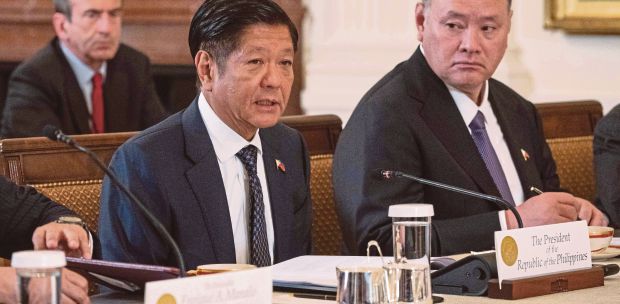Trying to fill Corazon Aquino's shoes, who not only sparked the People Power Revolution in 1986 but also became the 11th Philippine president, is no easy feat.
Many thought Fidel Valdez Ramos would have a tough time coming just after her tenure and would have big shoes to fill after being elected the 12th president of the archipelagic nation.
Yet the West Point graduate and career military officer before entering politics showed that he would make the right call when it mattered.
The Philippine Armed Forces vice-chief of staff during the senior Ferdinand Marcos regime, Ramos, invariably by design or not, triggered the 1986 revolution.
The murder of opposition leader Benigno Aquino and a snap election cheating by Marcos sparked the civil resistance campaign.
Sensing the dictator's weakness, a group of young military officers led by defence secretary Juan Ponce Enrile plotted to seize power, but were found out.
Facing arrest, Enrile and his allies holed up in the military headquarters in Manila and appealed to the public to protect them from an imminent government attack.
Ramos joined the rebellion, inspiring many others to join the civil disobedience.
Also known as the EDSA revolution, it sent Marcos into exile and saw Corazon Aquino elected president.
Aquino, the first female Philippine president, repaid Ramos' backing for the revolution by appointing him military chief and thendefence secretary.
His appointment would prove crucial to her, as military rebels who sought to topple Marcos now turned their sights on her.
Ramos, who led loyalist forces, helped quash numerous coup attempts against Aquino between 1986 and 1989, bringing stability to the nation.
Following the revolution, the Philippine Constitution was amended to limit the presidential term to a single six-year term.
And so when the election came in 1992, Aquino endorsed Ramos, which was crucial in him winning the presidency despite opposition from the influential Catholic Church.
"She has done her job, which is to establish political freedom. But the second phase is to strengthen democracy. My priority is unifying the country," he had told the now-defunct weekly news magazine "Far Eastern Economic Review".
Known as Steady Eddie for his unflappable demeanour during the many upheavals when he was president from 1992 to 1998, he remains the first and only Protestant to win the top office in the overwhelmingly Catholic nation.
Born on March 18, 1928, in Lingayen, Pangasinan, he is credited with several achievements during his tenure.
Under his administration, the Philippines experienced a period of political stability and rapid economic growth and expansion.
He introduced the Philippines 2000 programme, aiming to make the country industrialised by 2000 onwards.
This programme is credited with revitalising the economy.
His policies and programmes to foster national reconciliation and unity led to peace agreements with Muslim separatists in Mindanao, Moro National Liberation Front (MNLF); engaging with New People Army communist insurgents; and bringing to the table military rebels who were against the Aquino government.
The peace agreement that Ramos brokered with military rebels and the MNLF won him and MNLF chairman Nur Misuari, as well as the Philippines, the 1997 Unesco Peace Prize, a first for Asia.
Peace brought dividends and saw renewed investor confidence in the economy.
Ramos pushed for the deregulation of key industries and the liberalisation of the economy.
He encouraged the privatisation of public entities, including the modernisation of public infrastructure, through the expanded build-operate-transfer concept.
Between 1993 and 1997, the economy recovered dramatically.
Gross national product averaged five per cent annually, and the total inflow of foreign exchange into the country outpaced Marcos and Aquino's tenures.
The average income of a family grew more during Ramos' administration than in the preceding two decades.
Blackouts and brownouts were common in the Philippines due to energy shortages, and it was another sector that Ramos sorted out, leading not only to economic revival but also benefiting the man on the street.
Economic wellbeing allowed Ramos to implement a comprehensive Social Reform Agenda.
This agenda addressed poverty, health, education and skills training, housing, environmental protection, children and the youth, the elderly and the handicapped, jobs and livelihood, agrarian reform and access to equal opportunity.
The "New York Times" said Ramos was a study in contradictions.
"Filipinos puzzled over the deeds and character of a Protestant who became president of a Roman Catholic country, of a hard-line general who brought about liberal economic, political and social changes in a nation exploited for centuries by Spanish and American colonialists, Japanese invaders and the infamous two-decade reign of Ferdinand and Imelda Marcos," said the daily.
The cigar-chomping Ramos, a Korean and Vietnam War veteran, died on July 31 at 94, with his funeral taking place on Aug 9.
"During his term from 1992 to 1998, Ramos achieved political stability and undertook major financial reforms and infrastructure projects that initiated nearly three decades of growth," said the "South China Morning Post".
The Hong Kong-based English daily added that Ramos' image as a reformist was so strong that even corruption scandals during his administration — such as the PEA-Amari deal, dubbed the grandmother of all scams — did not significantly dent his popularity.
For longtime friends who worked with him before he became president, Ramos was a man who was calm, cool and collected even in the tensest situations, said Filipino news portal Rappler.com.
That meant being on top of things despite coup threats during the Aquino administration, in which he served as military chief, and later, as defence secretary, said the portal.
"While President Cory (Aquino) was the enduring symbol of [democracy's] restoration, the role of then-general Ramos in ensuring preservation was often not talked about in great detail," former Senate president Franklin Drilon, who was justice secretary under the Cory Aquino and Ramos administrations, told the portal.
Ramos will be remembered for reviving the Philippines' economic and financial fortunes as well as unity, just as Aquino is remembered for restoring democracy.
Good-bye and rest in peace, Steady Eddie.
The writer is NST news editor
The views expressed in this article are the author's own and do not necessarily reflect those of the New Straits Times






